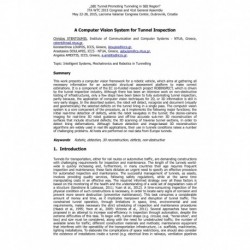Cart
0
0
No document
0,00 €
Total
Document successfully added to your shopping cart
Quantity
Total
There are 0 items in your cart.
There is 1 item in your cart.
Total documents
Total shipping
To be determined
Total
Search & filter
Search for a publication
Search & filter
Viewed documents
A Computer Vision System for Tunnel Inspection
wtc2015_full_stentoumis
C. Stentoumis / K. Loupos / A. Doulamis / A. Amditis
Tunnels for transportation, either for rail routes or automotive traffic, are demanding constructions with challenging requirements for inspection and maintenance. The length of the tunnels world-wide is quickly increasing and, furthermore, in many countries their age requires frequent inspection and maintenance; these facts dictates an urgent need to specify an effective procedure for automated inspection and maintenance. The successful management of tunnels, as assets, involves providing quality services, following safety regulations, while at the same time manipulating costs in an effective way. The required informed strategy over all these factors is based on the monitoring of the health and the understanding of a wide set of degradation rules of a structure (Sandrone & Labiouse, 2011; Yuan et al., 2012). A time-consuming inspection of the physical condition of such constructions is necessary, in order to locate early signs of corrosion and prevent more severe destruction (preventive maintenance). This task consumes a considerable amount of money and time, as it implicates manpower and disruption of tunnel traffic. The constrained tunnel operation, through limitations in space, time, environmental and cost requirements, makes necessary the strict scheduling of inspection and maintenance procedures (Haack et al., 1995; Yoon et al., 2009; Victores et al., 2011). Several approaches have been proposed in an attempt to increase cost-efficiency in inspection through automation, despite the extreme difficulties of this task. To begin with, tunnel shape (e.g. circular, oval, "horse-shoe", and box) and size must be considered, along with the need for unobstructed traffic; the number of available lanes for traffic; different construction materials and methods; maintenance equipment that interferes with the operability of the transportation infrastructure, i.e. scaffolds, machineries, lighting installations. To elaborate the complications of space restrictions, one should also consider the existence of installations inside a tunnel (e.g. electrical lines in railways, ventilation pipelines




